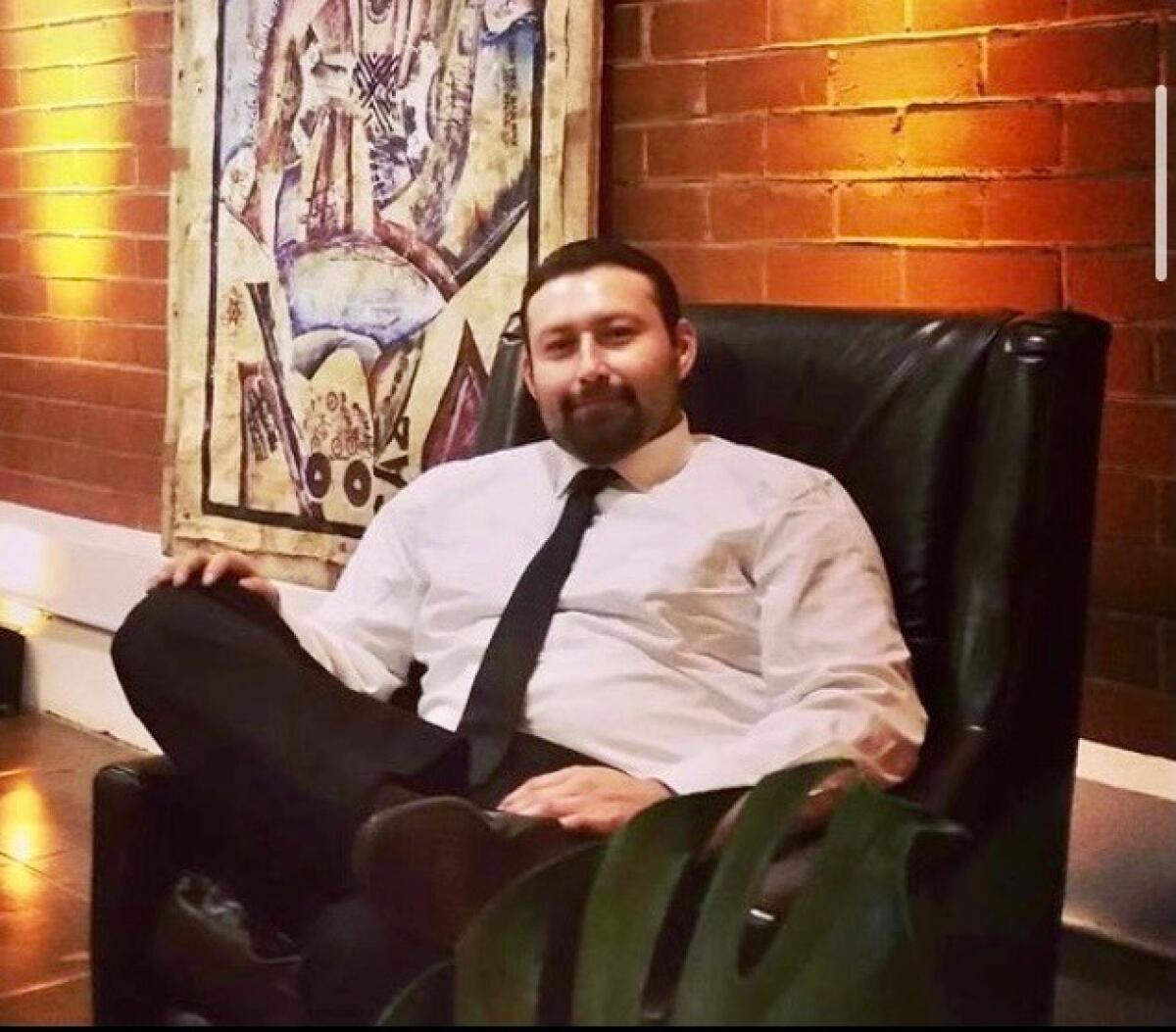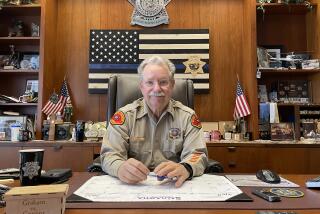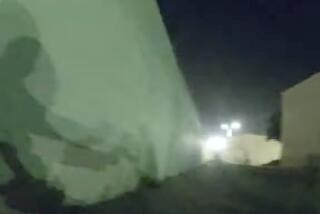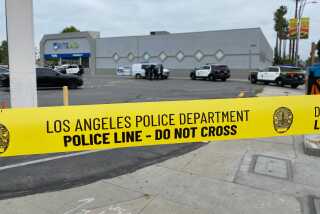Video of deputies killing suicidal man shows multiple failures, experts conclude

David Ordaz Jr. stood on the sidewalk outside his East L.A. home as sheriff’s deputies, as well as family members, yelled at him to drop a 12-inch kitchen knife.
Ordaz, 34, had told deputies he was upset because they wouldn’t shoot him. His sister had told a 911 dispatcher that Ordaz had talked about “suicide by cop,” and that she was “afraid for that.”
As a deputy yelled at Ordaz to “stand back,” several shot beanbag rounds at him from what appeared to be several yards away. Ordaz then advanced a few steps forward and was hit with 12 bullets in a barrage that continued even after he fell onto the pavement.
Body-camera footage released of the March 14 shooting, which occurred within minutes of the deputies’ arrival, has drawn criticism from policing experts as well as Sheriff Alex Villanueva, who said Friday that he had “grave concerns” about the shooting and had relieved one of the deputies of duty. The Sheriff’s Department told The Times it would not be able to comment further on the incident because of its active investigation.
The Times asked five policing experts to review the video released by the Sheriff’s Department, and they found fault in the number of shots fired at Ordaz or the earlier effort to deescalate the situation before it led to violence.
“Even if he [Ordaz] took a step towards the officers, it wasn’t that those officers were in immediate danger,” said Jonathan Smith, a former chief of the special litigation section of the Department of Justice’s Civil Rights Division, who called the incident “very concerning.”
“He wasn’t threatening, he wasn’t holding someone hostage, the knife wasn’t near anybody,” added Smith, executive director of the Washington Lawyers’ Committee for Civil Rights and Urban Affairs. “It did not look like he was charging or closing a distance to the officers in a way that poses a threat.”
Priscilla Ocen, a member of the Sheriff Civilian Oversight Commission and professor at Loyola Law School, called the shooting “a clear policy failure” that underscores how the department should not be responding to mental health calls.
“It looked like the deputies did not give Mr. Ordaz enough space and they did not speak with the family to come up with a strategy to effectively manage what was clearly a very volatile situation,” she said. “It did not seem there was enough time given to manage and deescalate the situation.”
The incident underscores the challenges of police responding to calls involving people with suspected mental illness, including suicide-by-cop attempts, in which a person tries to provoke officers to use deadly force. In a 2009 study of more than 700 officer-involved shootings nationwide, 36% of incidents were people attempting to provoke police force.
It’s possible, however, to avoid fatal encounters even in these incidents. A 2019 study of Los Angeles police, coauthored by the LAPD and Cal State Fullerton, that examined 419 of these cases between 2010 and 2015 found that officers used lethal force in a small number of incidents, killing four people. About 80% of the cases didn’t involve force.
Protests last year over the killing of George Floyd in Minneapolis invigorated calls to reduce police contact with the public in areas such as mental health, and some departments have already moved in that direction. A pilot program to divert 911 calls from people experiencing suicidal thoughts to certified mental health providers instead of Los Angeles police officers is being expanded into a 24-hour operation.
Ordaz, a father of three, had previously had encounters with law enforcement around mental health. A coroner’s report indicated that in 2007, Ordaz was placed on a 5150 hold, a detention of up to 72 hours for those deemed a threat to themselves or others, or for those gravely disabled due to a mental illness.
Federico Sayre, an attorney representing the Ordaz family in a federal wrongful death lawsuit against the county, said that in 2006 and 2007, deputies were called to the home when Ordaz was in a mental health crisis and were able to subdue him.
But things took a deadly turn on the afternoon of March 14. At a news conference last week, Gabriela Hernandez, Ordaz’s sister, said that she was “lost and completely confused about what happened to my brother David.”
The incident began when another of Ordaz’s sisters called 911 to ask for help with her brother.
“I’m currently with someone who is telling me they’re suicidal,” she is heard saying in a part of the call that was publicly released. “I was just wondering if you could guide me on what I can do to help them.”
She told the dispatcher they were sitting in Ordaz’s car outside their family’s home, that Ordaz was carrying a knife, and that she believed he was under the influence of methamphetamine.
In a narrated video, a Sheriff’s Department spokeswoman said that deputies had requested less-lethal weapons and a mental evaluation team.
Body-camera footage shows a deputy who arrived at the scene yelling for the car’s occupants to step out. Ordaz exited the driver’s-side door, holding a knife at his side.
A deputy trained a gun on Ordaz, telling him that they were there to help him. He said, “We’re not here to shoot you, dude, we’re here to help you out.”
The footage also shows deputies yelling at relatives who had gathered outside to go back in the home.
Experts who viewed the footage said that it was counterproductive for multiple deputies to have tried to communicate with Ordaz, potentially escalating the situation.
Gregory Gilbertson, a use-of-force expert at Centralia College in Washington state, said it would have been more appropriate for deputies to have designated one person — a sergeant on scene or someone trained in crisis intervention — to calmly speak with Ordaz.
Deputies should not have trained their guns at him knowing that he had spoken about wanting police to kill him, he added.
“They say, ‘We’re here to help you, Mr. Ordaz,’ while they’re pointing a gun at him,” Gilbertson said. “At that point, he’s not advancing at the officers.”
Vivian Lord, an expert on suicide-by-cop behavior and professor emeritus at the University of North Carolina at Charlotte, also said that in such situations police should attempt to establish a rapport with the individual to try to calm them.
In the Ordaz shooting, she said, multiple deputies addressed Ordaz, whose family member also shouted directions at him, creating more stimulation and confusion.
“Ideally, you would have one officer focus entirely on communicating with this subject,” she said. “You would have another officer continuing to try to communicate with the family members to get them back in the house.”
After Ordaz was shot with beanbag rounds, deputies yelled at him to “drop it,” referring to the knife. Ordaz was then shot as he advanced a couple of steps forward.
Smith, from the Washington Lawyers’ Committee for Civil Rights and Urban Affairs, said that while troubling, the shooting was not surprising given how law enforcement officials are trained that someone who has a knife and is dozens of feet away can charge and “close the distance between them and an officer in a very short period of time.”
Experts also called attention to how Ordaz continued to be shot at even after he hit the ground. The final shot occurred about two seconds after the gunfire had stopped. At that point, Ordaz was lying face-up on the sidewalk.
Seth Stoughton, a former Florida police officer and University of South Carolina law professor, said the volley of shots went on longer than necessary.
“He was fully on the ground,” he said. “The last shot has no justification at all.”
Stoughton emphasized how police sometimes need to engage less in order to avoid a dangerous confrontation.
“One of the most difficult lessons for policing is the issue of disengagement,” Stoughton said. “Could the deputies have parked down the street and waited for the mental health team?”
Charles “Sid” Heal, a retired Los Angeles County sheriff’s commander and use-of-force expert, agreed that the incident raised the question of whether police presence can make a situation worse and that the deputies should have done everything to buy time until the mental health team arrived.
“Because someone is suicidal, it doesn’t mean they are homicidal,” Heal said. “Time is on your side.”
More to Read
Sign up for Essential California
The most important California stories and recommendations in your inbox every morning.
You may occasionally receive promotional content from the Los Angeles Times.












